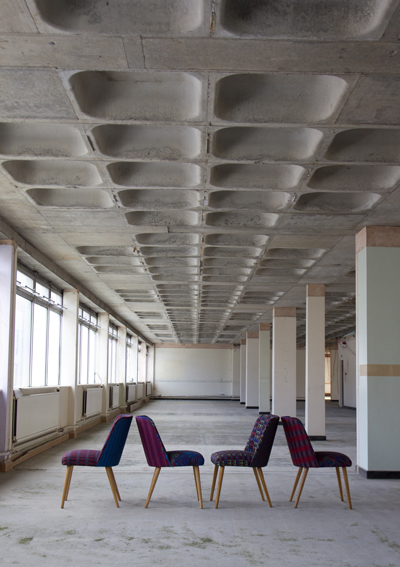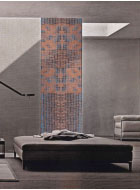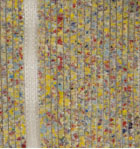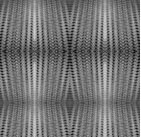Full -Time Faculty Teaching Position in Fiber and Material Studies: School of The Art Institute of Chicago
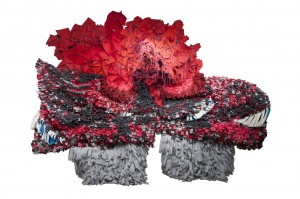 The School of the Art Institute of Chicago’s Department of Fiber and Material Studies announces a full-time, tenured or tenure track-position, beginning August 2013. The department seeks candidates with accomplished studio practices who are proficient in both hand and machine, and analog and digital technologies as applied to textiles/fiber and material studies, preferably with experience in Jacquard weaving. S/he will lead the curricular and pedagogical direction of the weaving area. The ideal candidate should be versed in historic and critical dialogue/theory as related to the field within a broader contemporary art and cultural discourse. Rank and salary are competitive with peer institutions, and are commensurate with quality of scholarship or practice, extent of teaching experience, and current professional standing.
The School of the Art Institute of Chicago’s Department of Fiber and Material Studies announces a full-time, tenured or tenure track-position, beginning August 2013. The department seeks candidates with accomplished studio practices who are proficient in both hand and machine, and analog and digital technologies as applied to textiles/fiber and material studies, preferably with experience in Jacquard weaving. S/he will lead the curricular and pedagogical direction of the weaving area. The ideal candidate should be versed in historic and critical dialogue/theory as related to the field within a broader contemporary art and cultural discourse. Rank and salary are competitive with peer institutions, and are commensurate with quality of scholarship or practice, extent of teaching experience, and current professional standing.
The Department of Fiber and Material Studies encourages an interdisciplinary approach to the investigation of relationships among concept, materiality, and process in contemporary art. Students use a broad range of media and methods with emphasis on the integration of textile, fiber and material study traditions, within an expanded contemporary art context. The department currently has five full-time faculty and up to fifteen part-time faculty. It has up to 20 dedicated MFA students, and over 750 undergraduate enrollments in 60 courses each year.
Continue reading →
Warp & Weft: Woven Textiles in Fashion, Art and Interiors. Jessica Hemmings
 Warp & Weft by Jessica Hemmings explores the world of woven textiles created for fashion, interiors and art. The experimental practice of some of the most exciting international textile artists and designers today, including Lia Cook, Nuno, Liz Williamson and Maggie Orth, reveals the range of interdisciplinary connections that inspire and inform contemporary woven textiles. A rich overview to contemporary weaving, this book is an excellent resource for everyone with an interest in weaving, fashion, interiors and art. The book will be published in Oct 2012.
Warp & Weft by Jessica Hemmings explores the world of woven textiles created for fashion, interiors and art. The experimental practice of some of the most exciting international textile artists and designers today, including Lia Cook, Nuno, Liz Williamson and Maggie Orth, reveals the range of interdisciplinary connections that inspire and inform contemporary woven textiles. A rich overview to contemporary weaving, this book is an excellent resource for everyone with an interest in weaving, fashion, interiors and art. The book will be published in Oct 2012.
Jessica Hemmings writes about textiles. She has taught at Central Saint Martins College of Art and Design, the Rhode Island School of Design, Winchester School of Art and Edinburgh College of Art. In 2010 she edited a collection of essays entitled In the Loop: Knitting Now published by Black Dog and has recently compiled The Textile Reader for Berg (2012) and written Warp & Weft for Bloomsbury (2012). She is currently Professor of Visual Culture and Head of the Faculty of Visual Culture at the National College of Art and Design, Dublin. Continue reading →
Ptolemy Mann & Anna Glasbrook – Gloucester Cathedral
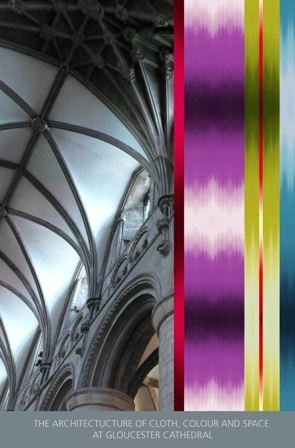 The Architecture of Cloth, Colour & Space
The Architecture of Cloth, Colour & Space
Stroud International Textiles will be showcasing new work by international textile artists and designers Ptolemy Mann and Anna Glasbrook in a new exhibition at Gloucester Cathedral. 

Colour saturated lengths of cloth will wrap the magnificent columns in the Nave of Gloucester cathedral.  Ptolemy Mann’s wall based hand dyed and woven textile artworks will also punctuate the cathedral space bringing a colourful softness and geometry to the viewer as they wander through the dramatic cathedral architecture.
Collaborative furniture pieces by Kristian Stringer and Marina Dragomirova will sit on top of the flagstones alongside Mann’s gem-coloured rugs celebrating the longstanding relationship between ecclesiastical architecture and commissioned textiles and objects. 

In the cloisters and hidden parts of the cathedral the architectural textile artist Anna Glasbrook will reveal her textile art pieces in the wintery light. Anna Glasbrook creates dynamic stitched architectural pieces that vibrate with vivid colour and movement. Using brightly coloured threads, she has developed an innovative and contemporary technique to construct vibrant three-dimensional drawings in space.
The gothic splendor of the cathedral will be a dramatic background to the vibrant and colourful textiles of these two inspiring, innovative and successful contemporary artists.
Details
Dates:  27th October – 31st December 2012
Venue: Â Gloucester Cathedral, 12 College Green Gloucester GL1 2LX
Open Times: 9 am – 6 pm
Admission: Free
Contact Phone: 01453 751056
Website:Â www.stroudinternationaltextiles.org.uk
Continue reading →
The Architecture of Cloth, Colour & Space – Symposium
 A One Day Symposium on the theme of The Architecture of Cloth, Colour & Space:
A One Day Symposium on the theme of The Architecture of Cloth, Colour & Space:
Saturday 27 October 2012
The Chapter House Room, Gloucester Cathedral.
Time: 11 am – 6 pm
Stroud International Textiles are delighted to be present a one day symposium of discovery and debate in the glorious setting of Gloucester Cathedral where the accompanying exhibition The Architecture of Cloth, Colour & Space is to be held.
Now, more than ever, we live in a climate where diversification and the exchange of ideas across several different disciplines is paramount; to survive creatively one has to apply our skills broadly but with finesse and personal signature. In keeping with the exhibition title: The Architecture of Cloth, Colour and Space this symposium aims to engage you in the working practice of exceptional people across the several disciplines the title defines: A colour theorist who engages with computer technology and paint, an artist who wraps facades with colour, an architect who circumnavigates the world through food and innovation, a weaver bridging the commercial craft divide, a textile artist creating installations for outside spaces; they all bring something different to their respective worlds and ours. Join us in the monumental gothic space of Gloucester Cathedral for a day of creative provocation and debate.
Dashing Tweeds & UAL: Central Saint Martins Weave Department Live Project
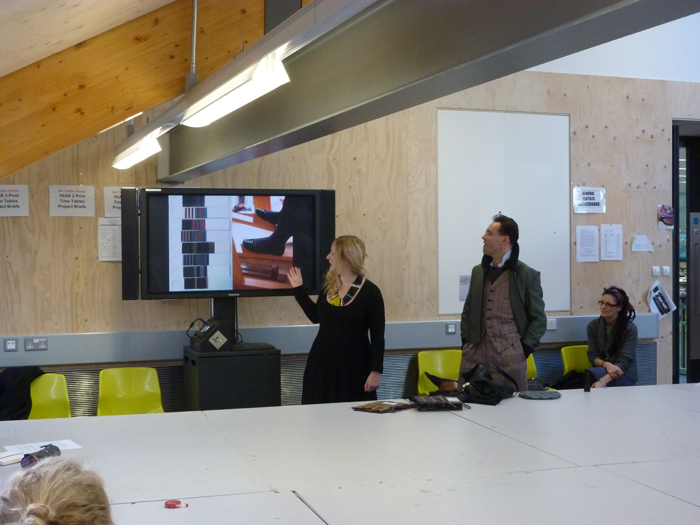
Central Saint Martins College of Arts & Design, University of The Arts London, second Year BA (Hons) Textile Design weave students worked on a menswear project set by Dashing Tweeds.
Dashing Tweeds create “a range of tweeds, accessories and clothing for the 21st century. The company was founded by photographer Guy Hills and Woven Textile Designer Kirsty McDougall, who share a dedication to challenging the menswear market with elegance, colour, heritage, technology, innovation and humour, developing fabrics and garments that will last a life time….†Dashing Tweeds website
Guy Hill and Kirsty McDougall briefed the students at the new Central Saint Martins Kings Cross campus, illustrating the companies’ work with images, talked about the history of tweeds and Guy Hill modeled a range of Dashing Tweeds clothing throughout the talk.
Keeping to the Dashing Tweeds urban influences, the students had to develop primary visual research choosing an area of London, being given the options of; exploring where they lived, an area that interested them or they had to find an interesting way of bringing together different aspects of London and capture the ‘flavour’ of the areas. This research was used to develop urban and textured tweed woven samples, which the students wove using 8 shaft looms. The students also had to develop computer aided design simulated weave shirting samples, to co ordinate with their tweeds, using specialist weave software.
Continue reading →
Kennet Valley Guild Residential Weaving Course

How to create amazing dimensional texture on 4 and 8 shafts
This is a Residential weaving course 19 – 21 October 2012 with Stacey Harvey-Brown at Wokefield Park, near Reading, with the Kennet Valley Guild of Weavers, Spinners & Dyers.
This 3-day workshop, held in Wokefield Park, near Reading, will be an opportunity to relax in beautiful surroundings, make new weaving friends and learn fun and surprising techniques to create texture in your woven fabrics.
You will learn how to use woven shibori for texture, along with overshot as you might never have used it before, and stitched double cloth
For more information and for booking details, please contact Lorna Goldsmith. lornagoldsmith@yahoo.co.uk
Photograph/designs: Stacey Harvey – Brown.
Top: overshot for texture, (pink 4 shaft, white and green 8 shafts, different threadings);
Centre: stitched double cloth for texture;
Bottom: shibori for texture, (blue 4 shaft, green and white 8 shafts, different threadings).
The TC2 Jacquard Loom – Digital Weaving Norway

Weaving on the new TC2 – Digital Weaving Norway
Stacey Harvey- Brown had the good fortune to be in Norway, at the factory of Tronrud Engineering where the TC1 and TC2 computer hand-jacquard looms are manufactured. She got to work within the factory environment where the staff were friendly, extremely knowledgeable and listened to the user, creating or adapting equipment directly from weaver feedback.
Vibeke Vestby, the dedicated and inspiring weaver and creator of the TC1 and now the TC2, invited Stacey over to test weave on the TC2 with non-traditional weave techniques to see how well the loom could cope. She reports that the loom coped very well. One or two suggestions were acted on immediately, and modifications were made which improved the weaving experience. The TC2 is a faster loom than its predecessor, which delighted her, as that was probably her main criticism of the TC1. She had found that the TC1 wouldn’t allow getting into a comfortable weaving rhythm when only using one shuttle, and this has been addressed with the TC2. Stacey is a fast weaver with one shuttle, and although the TC2 isn’t quite as fast as she is, she was still able to get into a good weaving rhythm. When you use more than one shuttle, the speed certainly is not an issue.
The action of the loom is smooth. The heddles now lift inside a frame – not dissimilar to traditional jacquard – and there are fewer ends that misbehave. She had 2 that refused to co-operate out of 2640. Stacey has more than that on my baby jacquard sample looms from the 1880s which are completely manual. The curing of that kind of problem is also much easier, and hopes to have more time to investigate this on another visit.
The actual hardware on the TC2 is much less frantic than the TC1. Instead of cables everywhere, there are simple modules with vacuum hoses. The bulk of the electronics are in the side frame so reducing the amount of trailing cables. The design of the frame is cleaner, less industrial and somehow more ‘friendly’.
Sian O’Doherty – Weave Designer
Textiles can be a powerful medium for creating illusions enabling artists to design concepts that are different to reality. Sian has been drawn to creating a textile collection that incorporates optical illusions, whereby her creations at second inspection reveal themselves differently, and are not what they first seem.
Her initial inspiration came from Google earth images- drawing reference from the patterns and vibrant colours created by estuaries. Her Welsh heritage is also apparent in many of her designs where she draws reference to historical Welsh textiles.
Fundamental to the body of work, has been the in depth technical exploration of multi layered weave structures combined with colour and the deviation of the expected path of a warp thread. Hand manipulated distortions rise and fall from structurally patterned ground weaves, emphasised by carefully considered bands of contrasting colour. Incredibly labour- intensive to produce, there is also no scope for errors. Impossible to commercially produce in volume they are a celebration of hand created textiles.
Keeping in mind the aspect of optical illusions Sian digitally developed her woven creations into new patterns that would be impossible literally to weave, but significantly look like weaves. She utilises modern technology to develop her woven creations into new dimensions, thus providing opportunities for maintaining handmade crafts yet with the possibilities of mass production.
Sian hopes to create a visual technical challenge that tricks the viewer when observing her designs, which she intends to be used primarily for interiors, both functional and aesthetic.
Continue reading →
Cockpit Arts – Clothworkers’ Foundation Award Winners
Cockpit Arts is extremely grateful to The Clothworkers’ Foundation for helping to establish and promote the Cockpit Arts / Clothworkers’ Foundation Awards 2012 which aims to support weavers who have recently graduated to help them develop their skills and pursue their career. All the Award winners can be seen at the Cockpit Arts Deptford Summer Open Studios 2012. Open 22-24 June. Address: 18-22 Creekside, London, SE8 3DZ. Opening times: Fri 6pm-9pm, Sat – Sun 11am-6pm. Cockpit Arts
The Clothworkers’ Foundation has been closely involved in the Award concept from the beginning, and are most indebted to Andrew Blessley, Director of the Foundation for introducing us to Philippa Brock, Woven Textiles Pathway Leader and Linsay Robinson, Senior Weave Technician, Central Saint Martins, who advised on the award timetable and purchase of looms and equipment. Cockpit Arts also sought initial advice about the concept of the Award from weaver, Eleanor Pritchard, who is based at Cockpit Arts Deptford.
The Selection Panel comprised Scarlet Oliver, representing The Clothworkers’ Foundation; Mary Restieaux, acclaimed ikat weaver and designer; Vanessa Swann, CEO of Cockpit Arts and Beckie Kingman, Studio Manager, Cockpit Arts. The six Award winners moved into Cockpit in mid-April 2012. They occupy shared space in two studios at Cockpit Arts’ incubator centre in Deptford (Studio 213 and 214) and have shared access to looms and equipment, generously funded by The Clothworkers’ Foundation with a grant of £25,000. The 6 Awards are being generously funded by the Foundation at £2,000 per Award with match funding of £2,000 being provided by each Award winner.
Cockpit Arts are looking forward enormously to supporting the young weavers with business development support over the coming year in order that their weaving businesses thrive and grow to national and international success.
Award Winners
Deptford Studio 213/214
Multimedia textile designer and artist Nadia holds a first class BA (Hons) from Central Saint Martins. Nadia digitally translates music into fabric, and this innovative fusion of music and weave has led to projects with the V&A and Microsoft Research Cambridge. Her fashion-led work includes collaborations with musicians Beth Ditto and Adele.
www.nadia-anne.comÂ
Deptford Studio 213/214
Soukaina is a surface designer specialising in weave who up-cycles yarns from plastic carrier bags. She was born and raised in Casablanca, Morocco and moved to London in 2005 where she studied at Central Saint Martins. She also won the New Designers Award in 2010.
www.soukaina-azizelidrissi.com
Deptford 213/214
Teresa specialises in hand woven and jacquard design cloth and explores themes around pattern, rhythm and sequence. She holds a textiles BA (Hons) from Chelsea College of Art & Design and an MA from Royal College of Art.


